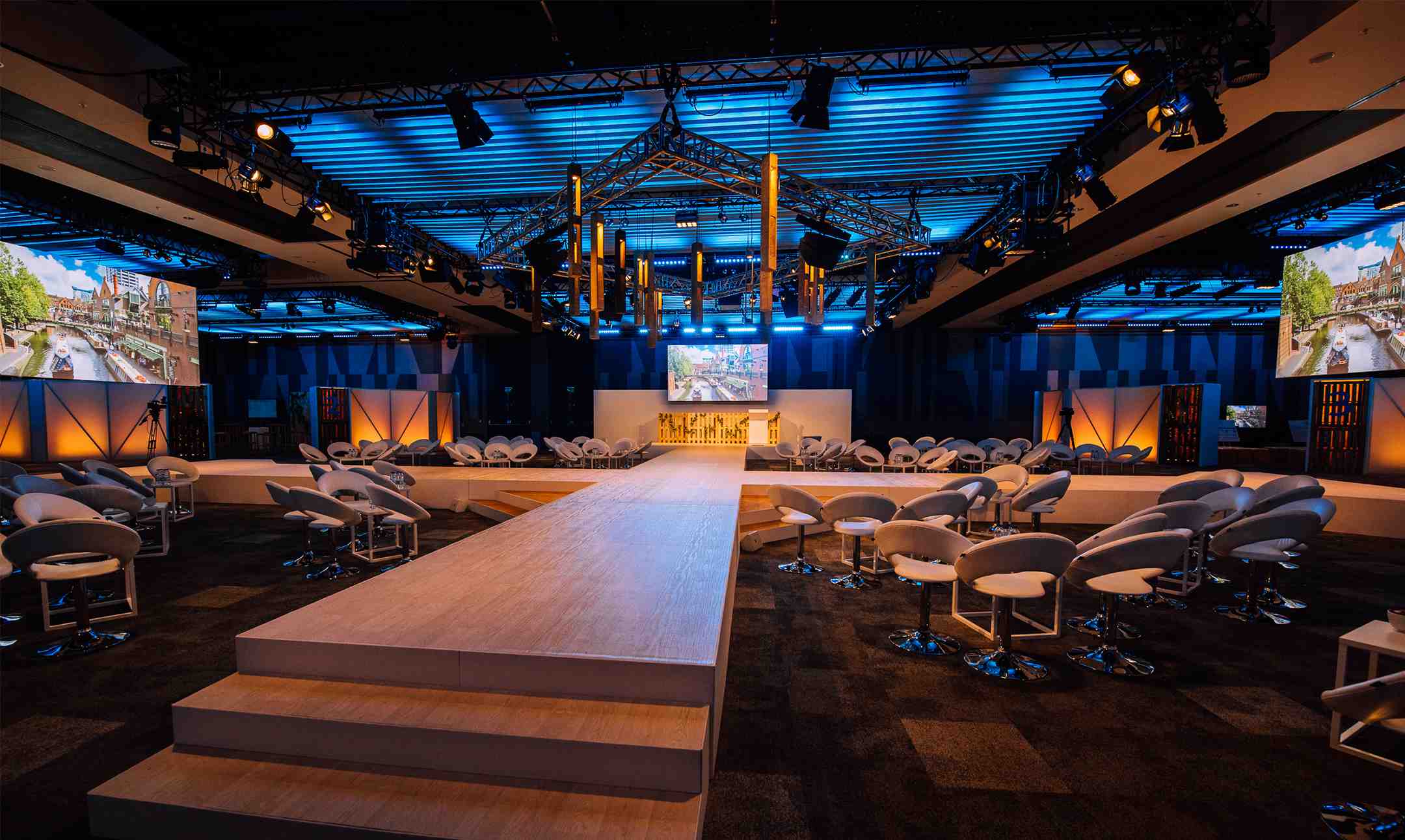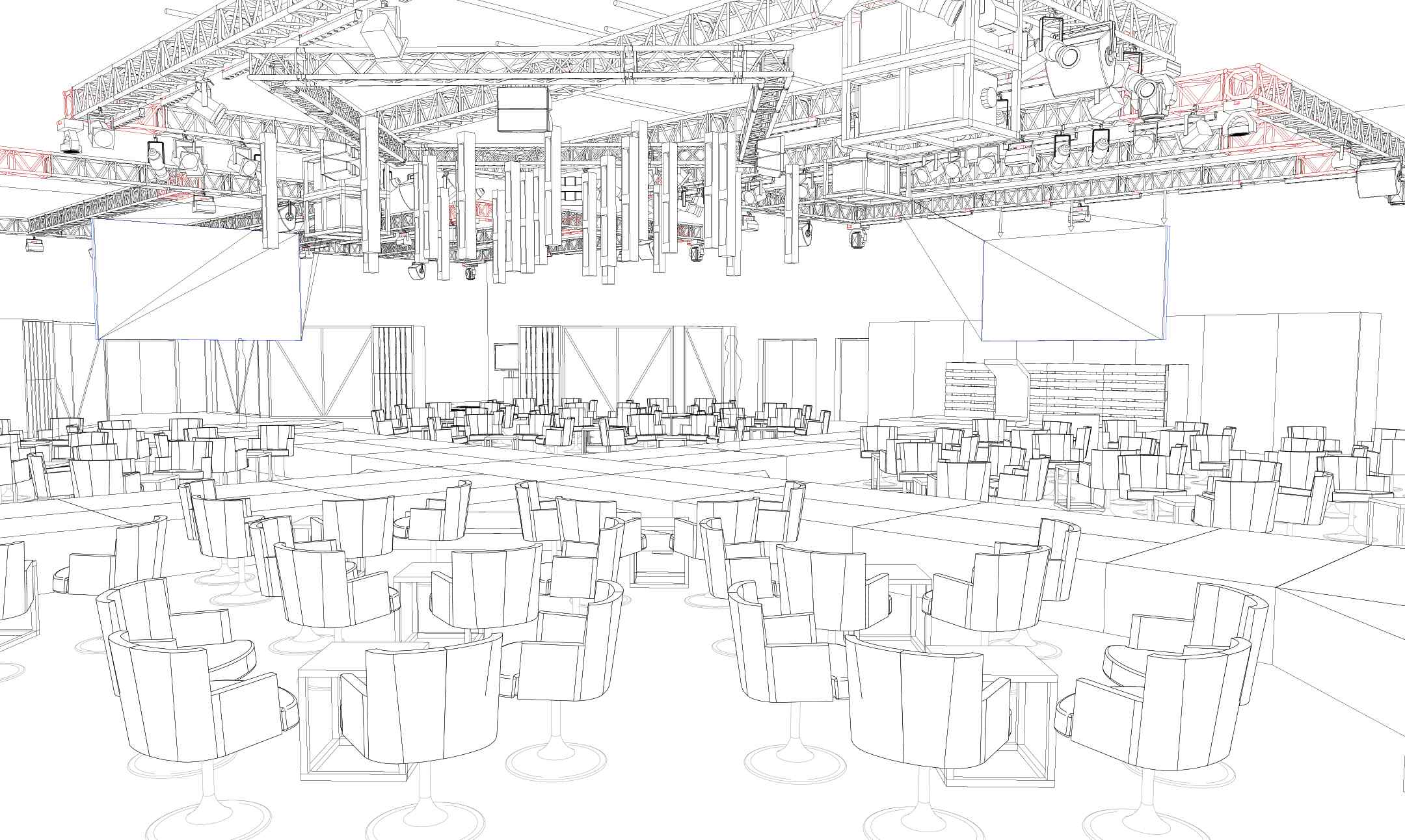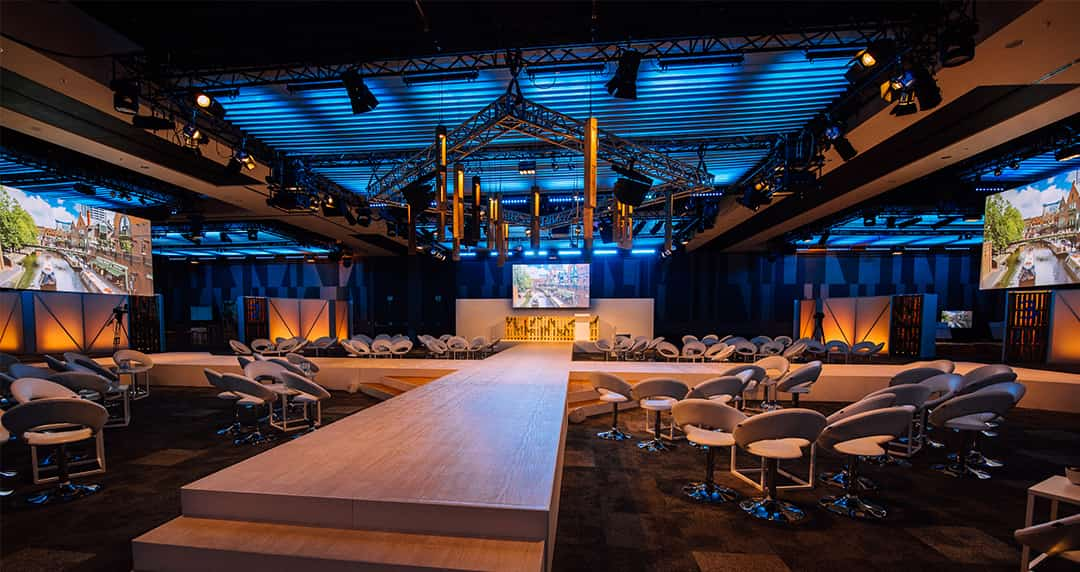Shining a Spotlight on Switching to Vectorworks
焦点公司: Stagestruck | 所在地: Hertfordshire, United Kingdom

Stagestruck started as a technical production company but quickly developed into a full-service agency, mostly serving the corporate events market. With 80 full-time team members, the firm coordinates everything themselves, including concept, design, documentation, and production. They’ve been operating for over 35 years.
To successfully plan and execute an event, Stagestruck must rely on effective collaboration — both with the client and internally.
“There are a number of different people involved in any design process we undertake,” said Tom Cordory, head of technical project management at Stagestruck. “We have a team of event producers and technical production managers. Then we have our design team, set construction team, technical team, and content team. We work together through the end to end process from initial design through to delivery.”
Among the different teams, 20-25 of Stagestruck’s employees used a mix of different CAD software: primarily AutoCAD, along with Revit, 3ds Max, Cinema 4D, and SketchUp. However, as their business grew, the firm realised they needed an all-in-one program to better suit their collaboration needs and to streamline their workflow.
They decided to make the switch to Vectorworks.
“We're still very much in the implementation, learning, and development phases” said Cordory. “At the moment, we're in the crossover between AutoCAD into Vectorworks."

The Story Behind the Switch
Before switching to Vectorworks, Stagestruck operated across a number of different platforms to create quality designs for their clients. At times this posed challenges to both efficiency and productivity, and Cordory knew they had to find a way to make projects easier to execute for all teams involved. He didn’t want to take that decision lightly.
“The whole process started when we were looking to switch over to a 3D package,” Cordory said. “We'd been working mostly in 2D AutoCAD and creating separate plan and elevation drawings, and that process seemed a little bit silly to us to just be working 2D. It also opened the door for errors.”
Previously, if they updated an elevation drawing and not the plan document, or vice versa, they could potentially run into problems with their drawings. They needed to find a new 3D package.
“We did quite a lot of comparisons and testing between Vectorworks and Revit, because, obviously, moving from AutoCAD onto Revit is quite a simple process because it has a very similar workflow” Cordory said. “It was almost creating a checklist to say, okay, what can Revit do? What can Vectorworks do? What's the comparison?”
From the results of this structured vetting process, Vectorworks appeared to be on par with Revit for everything Stagestruck needed, in terms of working from 2D to 3D, so once they started to work more intimately with the software, they were quite comfortable making the switch.
We have stopped starting new projects in AutoCAD. Everything's being done in Vectorworks.
“The beauty of Vectorworks is a much more collaborative approach between the technical production managers, the designers, and the set construction elements of what we do,” he said. “We can all work within the same package and still be able to see everything in 3D.”
Stagestruck transitioned via staged rollout.
“Initially, we took the core team, about eight of us, who we knew would pick the software up easily, and tasked them to develop our in-house stock library and our in-house work group library. And we put them all through a training course here,” said Cordory. “We then gave that group time to learn a little bit more, to get hands-on with it, and to start developing the best working processes for our ways of working.”
The firm also invested in several training sessions with the Vectorworks UK office and has more planned for the future. Once employees gained more experience, they planned to incorporate internal training processes as well.
The Benefits of Moving to Vectorworks Spotlight
Throughout their rollout and training process, the various teams at Stagestruck came across several different features they found quite helpful. One of these was point cloud objects.
“The point cloud integration is absolutely brilliant” said Cordory. “We can scan a venue, then produce a 3D point cloud which can be taken directly into Vectorworks; it’s absolutely brilliant for us. It's those tools that just make everything quicker, easier and more accurate to produce. It's a lot easier for us to calculate lens throws, compared to anything we were doing in AutoCAD where it was a more manual process.”
Automated reports saved them even more time, allowing quick communication across various teams. In one example, Cordory discussed passing along the necessary number of stage weights from the design team to the set department, then to the production management team responsible for setting up the final event. They did all this in Vectorworks.
“It’s these little things that will really save us a lot of time,” said Cordory. “
According to Cordory, developing a new workflow with Vectorworks has been “very nice and easy.” He appreciates the amount of time saved by only updating once and having that change reflected everywhere else in the software.
“In all, it’s valuable being able to work in one drawing, being able to check parts in and out so different departments can check out different elements and know that we can work on the same drawing at once,” said Cordory. “Essentially, you're not waiting on someone to finish their edits before someone else can start working on their element. It seems to work really well for us.”
Cordory went into further detail as to how this new workflow compares to what they had been dealing with previously.
“Now, we’re not creating something in 3ds Max and then creating it again in AutoCAD. We're not creating something in SketchUp and having to recreate it in AutoCAD. It's very much a more streamlined process,” he explained. “The fact that we draw something once and then we're able to get everything we need out of it, whether that be technical plans, 3D renders, sketches or output documents — I think that's going to be the biggest time saver for us.”
The biggest advantage of all, he claimed, is not having to work across multiple packages.
“It just really minimises errors and gets everybody on the same page, which is always good,” said Cordory. “It's very much helping all of our departments be aligned and working together on projects. I think we can easily say that we are saving 20% of our time, comparable to what we would be from doing things manually.”

Present Lessons and Future Directions
Cordory admits that he is pleasantly surprised at how seamlessly Stagestruck was able to switch to Vectorworks, reporting little to no problems.
“It's very much been a smooth process — definitely been faster as a transition than we thought it would be,” he said. “We thought we would be six months into this year before we got to the point where had our libraries at a suitable standard that we were happy with, and had everybody trained and happy to use it. But, already three months in, we had already decided not to start any new projects in AutoCAD and just work straight into Vectorworks. So, that kind of shows how easy it is to learn, and the fact that we were able to adapt and change so quickly is great for us.”
They’ve been so quick to adapt that the firm is already looking into trying some of the newer features in the software, such as the algorithmic modelling tool, Marionette.
“We've already started to develop a number of custom objects that allow us to have adaptable stock objects, so you just drop it in the object and then we can choose certain things that happen with them. That's a really big timesaver for us,” said Cordory. “We're not having to build individual components and change things. We can just have a single backdrop within and then select from the menu how we want it to appear and what's going to happen with it. It’s a really good feature, one we're going to keep exploring. We've already got four or five other things that we want to start programming. It's really powerful, really, really powerful.”
It's not very often you get excited about a piece of software.
In a similar vein, as an events-focused firm, Stagestruck has also started exploring Braceworks and how it can be integrated into their new workflow.
“Braceworks is going to come in our next phase of the rollout — meaning, how we’re actually going to be implementing Braceworks and using that more as a technical planning element. The design team will be more focused on learning more about the modelling and the rendering capabilities.”
To push those renderings to the next level, they’ve also started experimenting with the AR/VR capabilities of Vectorworks.
“We're keen to really explore AR/VR in detail to present our ideas in different ways with clients,” said Cordory, “to have some sort of AR or VR element to it, where we can show the designs off to the client in a different way, is really appealing to us.”
In Cordory’s eyes, the bottom line in exploring all of these functionalities is simple. “Streamline our process,” he said. “This is the main focus.”
As they’ve come across challenges in adjusting the company’s learning curve, Cordory claimed they can find answers fairly quickly online. “The online communities in particular are brilliant. I think most of us are now on Vectorworks' Facebook group. It's really useful!” he exclaimed.
Opening Doors Via Vectorworks
When asked what advice he would give to other firms considering making the switch to Vectorworks, Cordory suggested keeping a structured, solid plan. By presenting this new software with a staged rollout, Stagestruck could maintain productivity for active projects while keeping their options open for future projects they’d like to plan completely in Vectorworks.
“The switch is opening up a lot of doors,” said Cordory. “I think it’s quite exciting for us as a business to know there's a lot of potential for us to get more out of the software and to grow how we're working proactively. It's exciting. We're excited about it. It's not very often you get excited about a piece of software.”
Images courtesy of Stagestruck.

